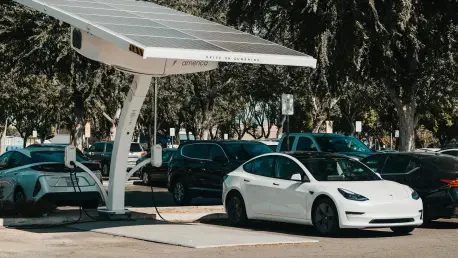Introduction
Imagine a world where the hum of electric vehicles (EVs) dominates city streets, yet the barrier to owning one remains stubbornly high for many. Despite a remarkable surge in EV adoption, with a record 10.5% market share in the U.S. during a recent quarter, the challenge of affordability looms large as federal incentives vanish. This shift underscores a pivotal moment in the fight against climate change, where making EVs accessible to the average consumer is no longer just an option but a necessity to reduce reliance on fossil fuels. The focus here is on how the market is responding to the expiration of significant tax credits, exploring innovative pricing strategies by automakers, and examining the broader implications for a sustainable future.
The EV Market Shift: Navigating Post-Tax Credit Challenges
Surge in Sales and Market Dynamics
The EV sector recently witnessed an unprecedented spike in sales, achieving a 10.5% market share in the U.S. during the third quarter, largely driven by consumers racing to claim a $7,500 federal tax credit before it expired. Major automakers such as Tesla, Ford, and General Motors reported substantial demand increases during this period, reflecting a consumer eagerness to transition to cleaner transportation. This surge highlights the profound impact of financial incentives on purchasing decisions, shaping market behavior in a short window of time.
However, the enthusiasm is tempered by concerns over future sales trajectories. Ford CEO Jim Farley has publicly cautioned that without such incentives, the current market share could potentially halve in upcoming quarters. This prediction points to a critical juncture for the industry, where sustaining momentum without government support becomes a pressing challenge for manufacturers and policymakers alike.
Real-World Responses to Incentive Loss
In the wake of the tax credit expiration, several automakers have taken decisive steps to maintain consumer interest through price adjustments. Hyundai, for instance, slashed the base price of its Ioniq 5 to $35,000, a reduction of nearly $9,800, making it a competitive option in the market. Similarly, Nissan has introduced a restyled Leaf priced under $30,000, boasting an impressive 300-mile range, catering to budget-conscious buyers seeking value and efficiency.
Looking ahead, General Motors is gearing up to launch a revamped Chevrolet Bolt by next year with a base price below $30,000, aiming to rival traditional gasoline vehicles in cost. Additionally, Rivian plans to roll out its R2 SUV at $45,000 in the near future, further signaling a strategic pivot toward affordability across the industry. These moves illustrate a concerted effort to bridge the price gap that often deters potential EV buyers.
Industry Perspectives on Affordable EV Solutions
Insights from industry leaders shed light on the complexities of sustaining EV growth in the absence of federal support. Ford CEO Jim Farley has emphasized the difficulty of maintaining market share without incentives, pointing to the need for alternative strategies like cost reduction and enhanced consumer financing options. His perspective underscores a broader industry realization that affordability is key to preventing a significant drop in adoption rates.
Complementing this view, sustainability advocates like Dr. Jane Goodall have stressed the urgency of integrating environmental health into economic frameworks. Speaking at a recent summit, she advocated for affordable green technologies as essential to driving mass adoption, arguing that planetary well-being must guide business decisions. Her call for courage among leaders to prioritize conservation over short-term gains resonates deeply within the context of making EVs accessible to all.
Future Outlook: Affordability and Innovation in EVs
The trajectory of the EV market suggests a promising trend toward sub-$30,000 vehicles, with manufacturers like General Motors and Ford exploring competitive leasing options to ease the financial burden on consumers. This push toward lower price points aims to democratize sustainable transportation, challenging the perception of EVs as luxury items and opening the door to a wider demographic. Such developments could redefine mobility in urban and rural settings alike.
Beyond pricing, innovations like virtual power plants (VPPs) are gaining traction as a means to support the growing EV infrastructure. California’s recent pilot program, which aggregated residential batteries into a 500-megawatt grid resource, demonstrated how VPPs can enhance stability during peak demand, a crucial factor as EV usage increases. This approach not only supports renewable energy integration but also empowers households to contribute to a more resilient energy system.
Yet, challenges persist, particularly with political resistance and potential policy rollbacks, such as funding cuts for climate initiatives under certain administrations. These hurdles threaten to slow progress, highlighting the importance of bipartisan support to ensure systemic change. If such collaboration emerges, the potential for transformative advancements in sustainable transport and energy management remains significant, paving the way for a greener landscape.
Conclusion
Reflecting on the journey of affordable electric vehicles, it becomes evident that the market has adapted with resilience through strategic pricing and innovative solutions like virtual power plants, even as federal incentives faded. The insights from industry leaders and advocates like Dr. Jane Goodall underscore an ethical imperative to prioritize sustainability, driving home the urgency of accessible green technology. Moving forward, stakeholders must tackle the next steps by fostering collaboration among consumers, businesses, and policymakers to dismantle remaining barriers, ensuring that the vision of widespread EV adoption transforms into tangible reality through sustained innovation and advocacy.









